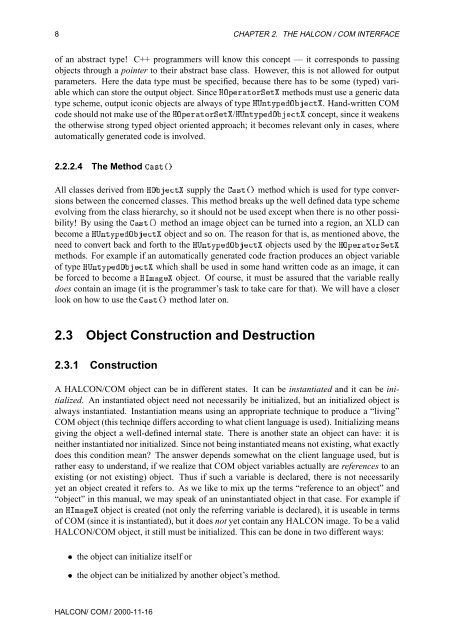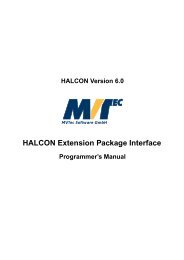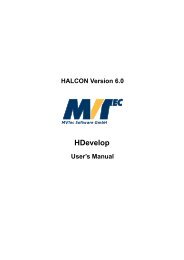HALCON/COM User's Manual
HALCON/COM User's Manual
HALCON/COM User's Manual
Create successful ePaper yourself
Turn your PDF publications into a flip-book with our unique Google optimized e-Paper software.
8 CHAPTER 2. THE <strong>HALCON</strong> / <strong>COM</strong> INTERFACE<br />
of an abstract type! C++ programmers will know this concept — it corresponds to passing<br />
objects through a pointer to their abstract base class. However, this is not allowed for output<br />
parameters. Here the data type must be specified, because there has to be some (typed) variable<br />
which can store the output object. Since ÀÇÔÖØÓÖËØ methods must use a generic data<br />
type scheme, output iconic objects are always of type ÀÍÒØÝÔÇØ. Hand-written <strong>COM</strong><br />
code should not make use of the ÀÇÔÖØÓÖËØ/ÀÍÒØÝÔÇØ concept, since it weakens<br />
the otherwise strong typed object oriented approach; it becomes relevant only in cases, where<br />
automatically generated code is involved.<br />
2.2.2.4 The Method ×Ø´µ<br />
All classes derived from ÀÇØ supply the ×Ø´µ method which is used for type conversions<br />
between the concerned classes. This method breaks up the well defined data type scheme<br />
evolving from the class hierarchy, so it should not be used except when there is no other possibility!<br />
By using the ×Ø´µ method an image object can be turned into a region, an XLD can<br />
become a ÀÍÒØÝÔÇØ object and so on. The reason for that is, as mentioned above, the<br />
need to convert back and forth to the ÀÍÒØÝÔÇØ objects used by the ÀÇÔÖØÓÖËØ<br />
methods. For example if an automatically generated code fraction produces an object variable<br />
of type ÀÍÒØÝÔÇØ which shall be used in some hand written code as an image, it can<br />
be forced to become a ÀÁÑ object. Of course, it must be assured that the variable really<br />
does contain an image (it is the programmer’s task to take care for that). We will have a closer<br />
look on how to use the ×Ø´µ method later on.<br />
2.3 Object Construction and Destruction<br />
2.3.1 Construction<br />
A <strong>HALCON</strong>/<strong>COM</strong> object can be in different states. It can be instantiated and it can be initialized.<br />
An instantiated object need not necessarily be initialized, but an initialized object is<br />
always instantiated. Instantiation means using an appropriate technique to produce a “living”<br />
<strong>COM</strong> object (this techniqe differs according to what client language is used). Initializing means<br />
giving the object a well-defined internal state. There is another state an object can have: it is<br />
neither instantiated nor initialized. Since not being instantiated means not existing, what exactly<br />
does this condition mean The answer depends somewhat on the client language used, but is<br />
rather easy to understand, if we realize that <strong>COM</strong> object variables actually are references to an<br />
existing (or not existing) object. Thus if such a variable is declared, there is not necessarily<br />
yet an object created it refers to. As we like to mix up the terms “reference to an object” and<br />
“object” in this manual, we may speak of an uninstantiated object in that case. For example if<br />
an ÀÁÑ object is created (not only the referring variable is declared), it is useable in terms<br />
of <strong>COM</strong> (since it is instantiated), but it does not yet contain any <strong>HALCON</strong> image. To be a valid<br />
<strong>HALCON</strong>/<strong>COM</strong> object, it still must be initialized. This can be done in two different ways:<br />
¯ the object can initialize itself or<br />
¯ the object can be initialized by another object’s method.<br />
<strong>HALCON</strong>/ <strong>COM</strong> / 2000-11-16
















